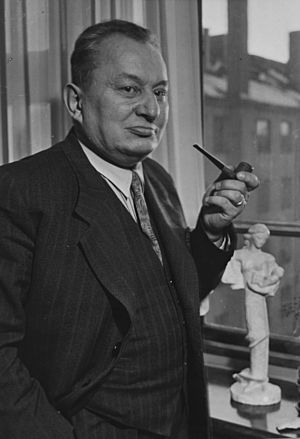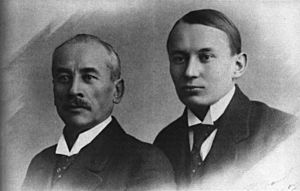Aarre Merikanto facts for kids
Quick facts for kids
Aarre Merikanto
|
|
|---|---|

Merikanto (c. 1950s)
|
|
| Born | 29 June 1893 Helsinki, Finland
|
| Died | 28 September 1958 (aged 65) Helsinki, Finland
|
| Spouse(s) | Meri Grönmark Evi Mähönen |
| Children | 4 (including Ukri Merikanto) |
| Parent(s) | Oskar Merikanto Liisa Häyrynen |
Aarre Merikanto (born June 29, 1893 – died September 28, 1958) was an important Finnish composer. He is known for his unique and modern music style.
Aarre was born in Helsinki, Finland. His father was Oskar Merikanto, a famous romantic composer. Aarre spent his childhood in Vilppula, Finland. He had two wives, Meri Grönmark and Evi Mähönen, and four children. One of his sons, Ukri Merikanto, became a sculptor.
Aarre Merikanto is seen as a key figure in early Finnish modern music. His opera called Juha is one of his most famous works. It became very popular after his death. He also taught music at the Sibelius Academy from 1951 to 1958. Many future Finnish composers learned from him, including Einojuhani Rautavaara and Aulis Sallinen.
Contents
His Musical Journey
Aarre Merikanto studied music in different cities. He went to Helsinki in 1911, Leipzig from 1912 to 1914, and Moscow from 1916 to 1917.
Early Style and Modernism
At first, Merikanto's music sounded like traditional Finnish romantic music. But in the 1920s, he started to create his own modern style. This style was very new and different. It was called "atonal," meaning it didn't follow traditional musical keys.
People had mixed feelings about his new music. His "Schott" Concerto won an award in Germany. However, audiences and critics in Finland didn't always like his modern pieces. For example, his opera Juha was never performed while he was alive. Today, it is considered one of his best works.
Change in Style
Because of the mixed reactions, Merikanto slowly changed his style in the 1930s. He moved towards a more traditional sound. This new style was based on Neoclassicism, which looked back to older, clearer musical forms.
His work was also part of the music event at the 1948 Summer Olympics. This shows how recognized his work was, even if it wasn't always popular at home.
Aarre Merikanto passed away in Helsinki on September 28, 1958, at the age of 65.
Main Works

Here are some of Aarre Merikanto's most important musical pieces:
- Juha, an opera (finished in 1922; first performed in 1963)
- Symphony No. 1 in B minor (1916)
- Symphony No. 2 in A major (1918)
- Symphonic Study (1928)
- Symphony No. 3 (1953)
- Violin Concerto No. 1 (1915)
- Violin Concerto No. 2 (1925)
- Violin Concerto No. 3 (1931; later destroyed by him)
- Violin Concerto No. 4 (1954)
- Piano Concerto No. 1 (1913)
- Piano Concerto No. 2 (1937)
- Piano Concerto No. 3 (1955)
- Cello Concerto No. 1 (1919)
- Konzertstück, for cello and a small orchestra (1923)
- Cello Concerto No. 2 (1941)
- Lemminkäinen, a symphonic poem (1916)
- Pan, a symphonic poem (1924)
- Notturno, a symphonic poem (1928)
- The Abduction of Kyllikki, a symphonic poem (1936)
- Schott Concerto, for violin, clarinet, horn, and string sextet (1925)
- Nonet (1926)
- Fantasia (1923)
- Ten Pieces for Orchestra (1930)
- Olympic Fanfare (1939)
- Song of the City by the Sea, a cantata (1949–1950)
- Genesis, a cantata (1955)
Images for kids
See also
 In Spanish: Aarre Merikanto para niños
In Spanish: Aarre Merikanto para niños



